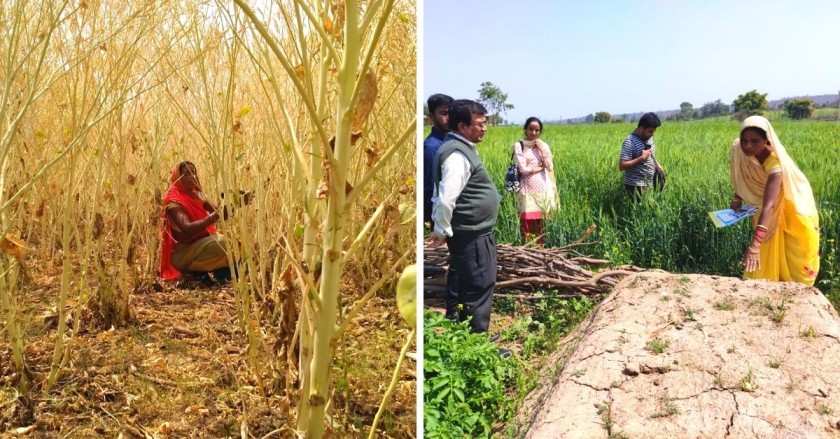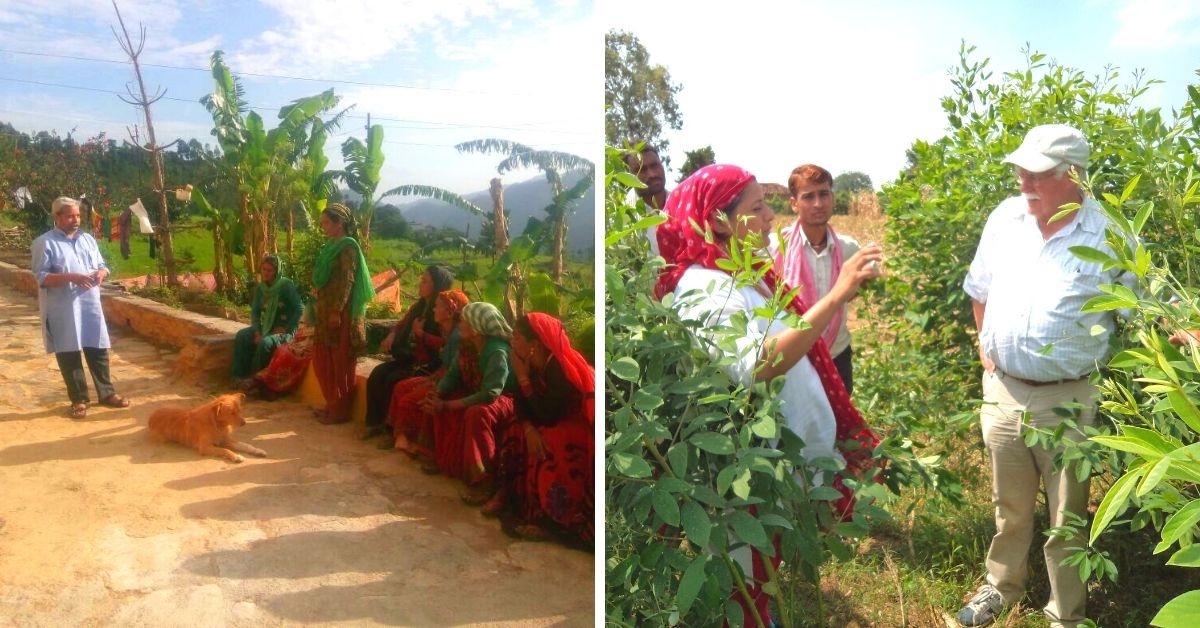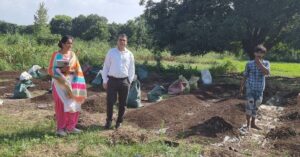Scientist Helps 50000 Farmers Switch To ‘Madagascar Method’, Increase Yield By 50%
Debashish Sen introduced the System of Rice (or Root) Intensification (SRI) technique to farmers in Uttarakhand, Himachal Pradesh and Madhya Pradesh in 2006, which was originally invented in the 1980s in Madagascar.

In Madhya Pradesh’s Shahpur Khurd village, Kavita Singh is busy cutting her freshly harvested sikiya variety of rice, which stands tall at 1.5 metres on her three-acre field. Judging from the heavy-looking grains and tillers (stems produced by grass), Kavita predicts this is going to be her best-ever harvest in terms of yield. The high yields are also reflected in her other crops, including maize, mustard and chickpeas.
Her situation, she says, was very different three years ago. At that time, she was growing only rice in a cramped space and shallow water, just like other farmers in the Panna district region. While she was planting more seeds per square metres in the conventional method, the yield was less than what she gets now.
“Initially, I was hesitant to adopt a new technique that required planting fewer crops. I thought it would be a waste of space, in addition to being more labour intensive. But the staggering results painted a different picture,” Kavita tells The Better India.

Kavita uses a farming technique called System of Rice (or Root) Intensification (SRI), which requires less water and seeds, but doubles the output. The system, which was invented in Madagascar in the 1980s, centres on mitigating chemical fertilisers and thereby improving soil, groundwater and nutrients. The method was developed by Henri de Laulanie, a French Jesuit priest and agronomist, and taken around the world by Professor Norman Uphoff, director of the International Institute for Food, Agriculture and Development at Cornell University.
Kavita was introduced to this technique by Debashish Sen, director at the People Science Institute (PSI). In 2006, he and his team of agri-experts began training farmers based in Uttarakhand, Himachal Pradesh and Madhya Pradesh.
“The rice plants are kept alternately wet and dry instead of being flooded. The spacing between each plant provides more oxygen, and minimises the competition between plants for nutrients and sunlight. This makes them more resilient to flood and drought. SRI came to India in the 2000s, and when we first learned about it, we started with just paddy cultivation. Gradually, we executed the technique on other crops, including wheat, maize and pulses, to name a few,” Debashish tells The Better India.
According to him, PSI has helped close to 50,000 farmers switch from conventional farming methods to SRI in the last 15 years. PSI is a non-profit research and development organisation that provides technical knowledge and guidance to farming communities to promote a sustainable livelihood.
The Better India speaks at length with Debashish to understand SRI, its process and benefits, and why it can be a long-term sustainable solution without burning a hole in a farmer’s pocket.
How it works

The most vital aspect of SRI, which determines its success, is transplanting the plants to the field when they are 7-8 days old (2 leaves per seedling), in contrast to 30-60 days in a conventional method. Another important step is giving water at critical stages of the growth cycle. Even though the system can be more labour intensive, as was Kavita’s experience, the exceptional results cover the labour costs.
Here’s the step-by-step process:
- Develop nursery beds to raise seedlings. Apply manure around the seedling and mulch it with paddy straw or any agro-waste. Water it daily till two leaves appear. You can use gunny bags for germination as well.
- The process of land preparation is similar to that in the conventional method. Make sure you level the land so that water is applied evenly. Mark the places where seeds will be sown, so that they are equidistant.
- Depending on the seed variety and soil conditions, plant the seedlings at a distance of 25 cm or ten inches on the main field. If the soil is nutritious, increase the spacing.
- Use organic fertilisers like jeevamrutha, panchgavya, and so on, thrice for healthier and faster growth.
- Since there are fewer seedlings, the weed growth is faster. Keep removing them.
- Due to alternate drying and wetting of land, the water usage is cut down by 40-50%. It also increases microbial activities.
- Since younger seedlings are shorter in height, they need less water. Just wet the soil in the beginning, and water only when you see cracks.
Advantages and challenges

PSI’s pilot project was carried out in 2006 in three villages of Uttarakhand. Twelve farmers were roped in, and saw their yield increase by 50-100%. Seeing these results, 60 more came on board the year after. By the fourth year, the number had touched 1,000. At this point, civil society organisations and state agriculture departments extended financial support.
“We didn’t find success at the very beginning. Convincing farmers to shed their traditional practices and to trust us was hard. Some left SRI in between, stating that alternate drying isn’t feasible as the land was rain-fed. Our package didn’t suit all farmers, so we had to tailor the process as per their requirements. We identified farmers who were willing to take a risk and innovate to inspire other farmers, and the strategy worked,” Debashish explains.
The biggest takeaway for Debashish and his team was realising that farmers are the real scientists, he says. They have to research weather, soil fertility, and crop variety every day to ensure a decent outcome. Debashish once found a farmer in Himachal Pradesh putting less water than required. Upon inquiry, the farmer said the irrigation water that came directly from the stream was cold, which would damage the younger seedlings. Debashish wouldn’t have realised it, given that he wasn’t actually farming himself. Another lesson he learned was using varieties that need a shorter duration to harvest.
In 2008, when the system was implemented beyond rice cultivation, Uttarakhand and Himachal Pradesh were experiencing drought-like conditions. Yet, the yield was high as compared to the conventional method. For example, the yield of maize had risen by 35%, and pulses by 25%. Rajma saw a jump of 50%.

Collective farming is another impactful change that has occurred, says Vinod Niranjan, a master trainer of PSI based in Panna. He has trained close to 1,000 farmers on SRI over the last eight years.
“Farmers practising SRI in a particular region realised each of them excel in a particular activity, such as sowing, cutting or mulching. In some regions, one farmer will sow in another’s fields, and another farmer will return the favour by doing something else. Even collective nurseries came up. They grow the seedling in a common nursery, and from there, transplant it to their respective fields,” says Vinod.
The benefits of SRI are many, from grain productivity enhancement, low input costs, increased incomes to drought resilience. If small-scale farmers like Kavita across India implement it, and their yields increase even by 20-30%, SRI could go a long way in mitigating farmers’ distress.
Edited by Divya Sethu
If you found our stories insightful, informative, or even just enjoyable, we invite you to consider making a voluntary payment to support the work we do at The Better India. Your contribution helps us continue producing quality content that educates, inspires, and drives positive change.
Choose one of the payment options below for your contribution-
By paying for the stories you value, you directly contribute to sustaining our efforts focused on making a difference in the world. Together, let's ensure that impactful stories continue to be told and shared, enriching lives and communities alike.
Thank you for your support. Here are some frequently asked questions you might find helpful to know why you are contributing?


This story made me
-
97
-
121
-
89
-
167














